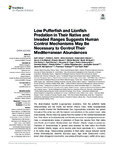Low Pufferfish and Lionfish Predation in Their Native and Invaded Ranges Suggests Human Control Mechanisms May Be Necessary to Control Their Mediterranean Abundances
| dc.contributor.author | Ulman, A | |
| dc.contributor.author | Harris, HE | |
| dc.contributor.author | Doumpas, N | |
| dc.contributor.author | Deniz Akbora, H | |
| dc.contributor.author | Al Mabruk, SAA | |
| dc.contributor.author | Azzurro, E | |
| dc.contributor.author | Bariche, M | |
| dc.contributor.author | Çiçek, BA | |
| dc.contributor.author | Deidun, A | |
| dc.contributor.author | Demirel, N | |
| dc.contributor.author | Fogg, AQ | |
| dc.contributor.author | Katsavenakis, S | |
| dc.contributor.author | Kletou, D | |
| dc.contributor.author | Kleitou, Periklis | |
| dc.contributor.author | Papadopoulou, A | |
| dc.contributor.author | Ben Souissi, J | |
| dc.contributor.author | Hall-Spencer, Jason | |
| dc.contributor.author | Tiralongo, F | |
| dc.contributor.author | Yildiz, T | |
| dc.date.accessioned | 2021-07-17T06:54:15Z | |
| dc.date.available | 2021-07-17T06:54:15Z | |
| dc.date.issued | 2021-07-16 | |
| dc.identifier.issn | 2296-7745 | |
| dc.identifier.issn | 2296-7745 | |
| dc.identifier.other | ARTN 670413 | |
| dc.identifier.uri | http://hdl.handle.net/10026.1/17356 | |
| dc.description.abstract |
<jats:p>The silver-cheeked toadfish (<jats:italic>Lagocephalus sceleratus</jats:italic>, from the pufferfish family Tetraodontidae) and the Pacific red lionfish (<jats:italic>Pterois miles</jats:italic>, family Scorpaenidae) have recently invaded the Mediterranean Sea. <jats:italic>Lagocephalus sceleratus</jats:italic> has spread throughout this entire sea with the highest concentrations in the eastern basin, while more recently, <jats:italic>Pterois miles</jats:italic> has spread from the Eastern to the Central Mediterranean Sea. Their effects on local biodiversity and fisheries are cause for management concern. Here, a comprehensive review of predators of these two species from their native Indo-Pacific and invaded Mediterranean and Western Atlantic ranges is presented. Predators of Tetraodontidae in general were reviewed for their native Indo-Pacific and Western Atlantic ranges, as no records were found specifically for <jats:italic>L. sceleratus</jats:italic> in its native range. Tetraodontidae predators in their native ranges included mantis shrimp (Stomatopoda), lizardfish (<jats:italic>Synodus</jats:italic> spp.), tiger shark (<jats:italic>Galeocerdo cuvier</jats:italic>), lemon shark (<jats:italic>Negaprion brevirostris</jats:italic>), sea snakes (<jats:italic>Enhydrina</jats:italic> spp.), catfish (<jats:italic>Arius</jats:italic> spp.), cobia (<jats:italic>Rachycentron canadum</jats:italic>), skipjack tuna (<jats:italic>Katsuwonus pelamis</jats:italic>), and common octopus (<jats:italic>Octopus vulgaris</jats:italic>). The only reported predator of adult <jats:italic>L. sceleratus</jats:italic> in the Mediterranean was loggerhead turtle (<jats:italic>Caretta caretta</jats:italic>), whereas juvenile <jats:italic>L. sceleratus</jats:italic> were preyed by common dolphinfish (<jats:italic>Coryphaena hippurus</jats:italic>) and garfish (<jats:italic>Belone belone</jats:italic>). Conspecific cannibalism of <jats:italic>L. sceleratus</jats:italic> juveniles was also confirmed in the Mediterranean. Pufferfish predators in the Western Atlantic included common octopus, frogfish (Antennaridae), and several marine birds. Predators of all lionfish species in their native Indo-Pacific range included humpback scorpionfish (<jats:italic>Scorpaenopsis</jats:italic> spp.), bobbit worms (<jats:italic>Eunice aphroditois</jats:italic>), moray eels (Muraenidae), and bluespotted cornetfish (<jats:italic>Fistularia commersonii</jats:italic>). Lionfish predators in the Mediterranean included dusky grouper (<jats:italic>Epinephelus marginatus</jats:italic>), white grouper (<jats:italic>Epinephelus aeneus</jats:italic>), common octopus, and <jats:italic>L. sceleratus</jats:italic>, whereas in the Western Atlantic included the spotted moray (<jats:italic>Gymnothorax moringa</jats:italic>), multiple grouper species (tiger <jats:italic>Mycteroperca tigris</jats:italic>, Nassau <jats:italic>Epinephelus striatus</jats:italic>, black <jats:italic>Mycteroperca bonaci</jats:italic>, red <jats:italic>Epinephelus morio</jats:italic>, and gag <jats:italic>Mycteroperca microleps</jats:italic>; Epinephelidae), northern red snapper (<jats:italic>Lutjanus campechanus</jats:italic>), greater amberjack (<jats:italic>Seriola dumerilli</jats:italic>), and nurse shark (<jats:italic>Ginglymostoma cirratum</jats:italic>). The sparse data found on natural predation for these species suggest that population control via predation may be limited. Their population control may require proactive, targeted human removals, as is currently practiced with lionfish in the Western Atlantic.</jats:p> | |
| dc.format.extent | 670413- | |
| dc.language.iso | en | |
| dc.publisher | Frontiers Media | |
| dc.subject | cannibalism | |
| dc.subject | invasive alien species | |
| dc.subject | marine protected areas | |
| dc.subject | predator-prey | |
| dc.subject | trophic ecology | |
| dc.subject | Lagocephalus | |
| dc.subject | Pterois | |
| dc.title | Low Pufferfish and Lionfish Predation in Their Native and Invaded Ranges Suggests Human Control Mechanisms May Be Necessary to Control Their Mediterranean Abundances | |
| dc.type | journal-article | |
| dc.type | Journal Article | |
| plymouth.author-url | https://www.webofscience.com/api/gateway?GWVersion=2&SrcApp=PARTNER_APP&SrcAuth=LinksAMR&KeyUT=WOS:000680040800001&DestLinkType=FullRecord&DestApp=ALL_WOS&UsrCustomerID=11bb513d99f797142bcfeffcc58ea008 | |
| plymouth.volume | 8 | |
| plymouth.publication-status | Published online | |
| plymouth.journal | Frontiers in Marine Science | |
| dc.identifier.doi | 10.3389/fmars.2021.670413 | |
| plymouth.organisational-group | /Plymouth | |
| plymouth.organisational-group | /Plymouth/Faculty of Science and Engineering | |
| plymouth.organisational-group | /Plymouth/Faculty of Science and Engineering/School of Biological and Marine Sciences | |
| plymouth.organisational-group | /Plymouth/PRIMaRE Publications | |
| plymouth.organisational-group | /Plymouth/REF 2021 Researchers by UoA | |
| plymouth.organisational-group | /Plymouth/REF 2021 Researchers by UoA/UoA07 Earth Systems and Environmental Sciences | |
| plymouth.organisational-group | /Plymouth/Research Groups | |
| plymouth.organisational-group | /Plymouth/Research Groups/Marine Institute | |
| plymouth.organisational-group | /Plymouth/Users by role | |
| plymouth.organisational-group | /Plymouth/Users by role/Academics | |
| dcterms.dateAccepted | 2021-06-15 | |
| dc.rights.embargodate | 2021-7-20 | |
| dc.identifier.eissn | 2296-7745 | |
| dc.rights.embargoperiod | Not known | |
| rioxxterms.versionofrecord | 10.3389/fmars.2021.670413 | |
| rioxxterms.licenseref.uri | http://www.rioxx.net/licenses/all-rights-reserved | |
| rioxxterms.licenseref.startdate | 2021-07-16 | |
| rioxxterms.type | Journal Article/Review |


